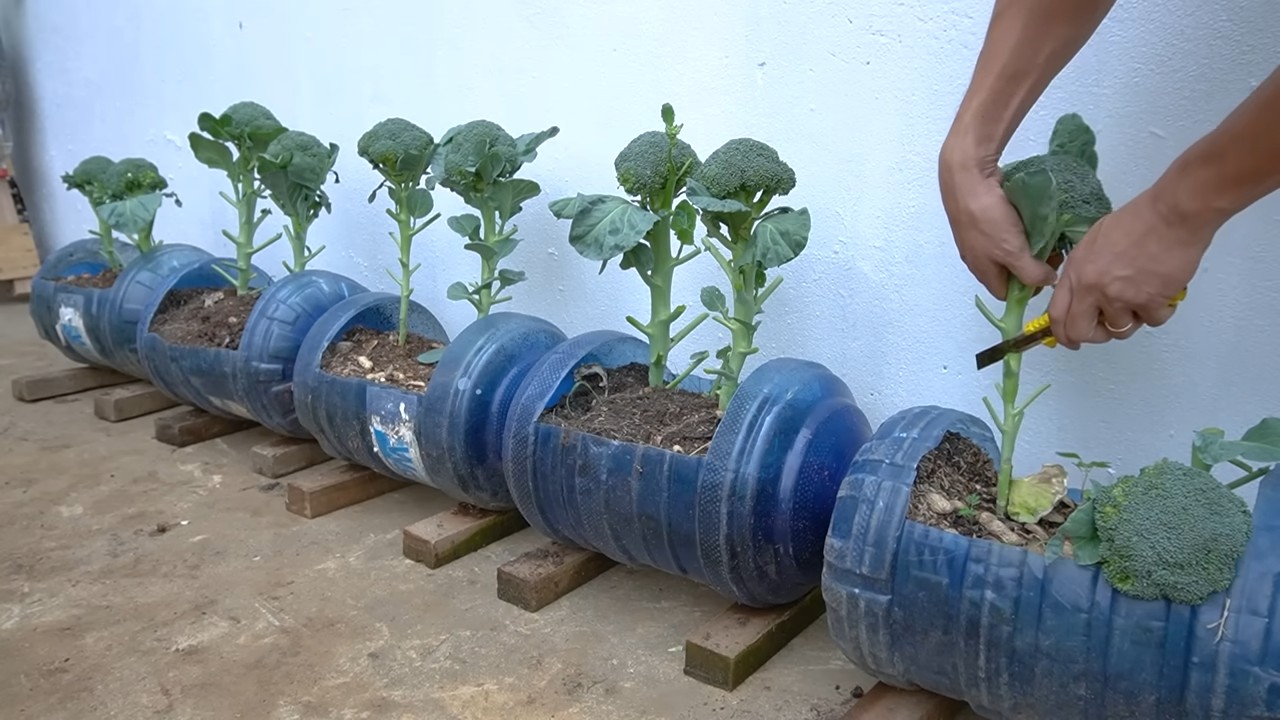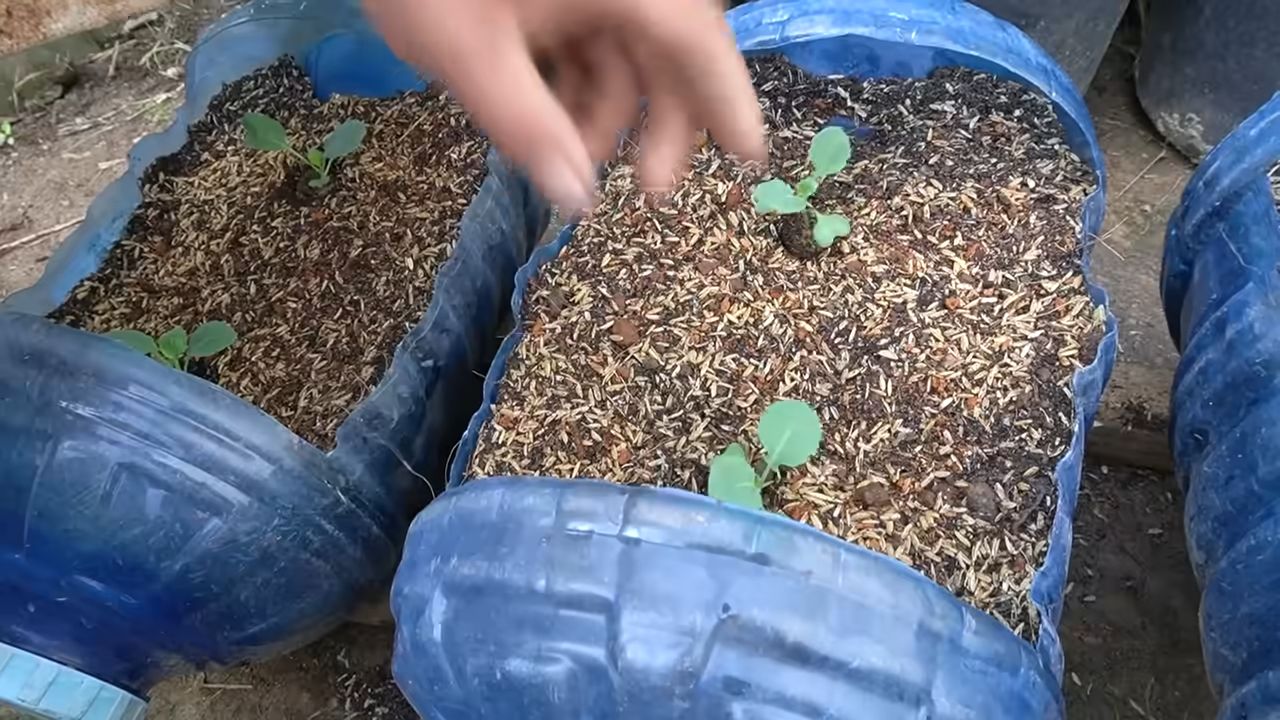Growing Broccoli at Home can seem daunting, but trust me, with a few simple tricks and a little DIY spirit, you can harvest your own delicious and nutritious broccoli right in your backyard! Forget those bland, overpriced heads at the grocery store. Imagine the satisfaction of serving up a vibrant, homegrown broccoli dish, knowing exactly where it came from and how it was grown.
Broccoli, a member of the Brassica family, has a rich history dating back to ancient Rome. The Romans highly valued it for its nutritional benefits and unique flavor. Over centuries, it has spread across the globe, becoming a staple in countless cuisines. But why settle for store-bought when you can cultivate your own?
In today’s world, where we’re increasingly conscious of food miles and the impact of industrial agriculture, growing broccoli at home offers a fantastic alternative. Not only will you have access to fresher, tastier broccoli, but you’ll also reduce your carbon footprint and gain a deeper connection to the food you eat. Plus, let’s be honest, there’s something incredibly rewarding about nurturing a plant from seed to table. So, let’s dive into some easy DIY tricks that will have you harvesting your own broccoli in no time!

Growing Broccoli at Home: A Beginner’s Guide
Hey there, fellow garden enthusiasts! I’m so excited to share my experience with growing broccoli at home. It’s surprisingly easier than you might think, and the taste of homegrown broccoli is absolutely unbeatable. Forget those bland, store-bought florets – we’re talking vibrant green, crisp, and bursting with flavor! This guide will walk you through every step, from seed to harvest, so you can enjoy your own delicious broccoli crop.
Choosing the Right Broccoli Variety
Before we even think about planting, let’s talk varieties. Not all broccoli is created equal! Some are better suited for certain climates and growing seasons. Here are a few of my favorites:
* ‘Waltham 29’: A classic, reliable variety that’s great for beginners. It produces large, uniform heads and is relatively heat-tolerant.
* ‘DiCicco’: This Italian heirloom variety is known for its early maturity and delicious side shoots after the main head is harvested.
* ‘Green Magic’: A hybrid variety that’s known for its heat tolerance and disease resistance. It produces tight, dark green heads.
* ‘Romanesco’: If you’re feeling adventurous, try growing Romanesco broccoli! Its unique fractal pattern is stunning, and the flavor is mild and nutty.
Consider your local climate and the length of your growing season when choosing a variety. Seed packets usually provide helpful information about each variety’s specific needs.
Starting Broccoli Seeds Indoors (Recommended)
While you *can* direct sow broccoli seeds, I highly recommend starting them indoors, especially if you live in an area with a short growing season. This gives your plants a head start and protects them from pests and harsh weather.
What You’ll Need:
* Broccoli seeds (of course!)
* Seed starting trays or small pots
* Seed starting mix (a light, well-draining mix is crucial)
* Watering can or spray bottle
* Grow lights (optional, but highly recommended)
* Heat mat (optional, but helpful for germination)
Step-by-Step Instructions:
1. Prepare your seed starting trays or pots: Fill each cell or pot with seed starting mix, leaving about half an inch of space at the top. Gently tap the trays to settle the mix.
2. Sow the seeds: Place 2-3 broccoli seeds in the center of each cell or pot. Cover the seeds with a thin layer of seed starting mix (about ¼ inch).
3. Water gently: Use a watering can or spray bottle to moisten the soil. Be careful not to overwater, as this can lead to damping off (a fungal disease that kills seedlings).
4. Provide warmth and light: Place the trays or pots on a heat mat (if using) and under grow lights. If you don’t have grow lights, place them in a sunny window, but be sure to rotate them regularly to prevent them from becoming leggy.
5. Maintain moisture: Keep the soil consistently moist, but not soggy. Check the soil daily and water as needed.
6. Thin the seedlings: Once the seedlings have their first true leaves (the second set of leaves), thin them to one plant per cell or pot. Choose the strongest, healthiest-looking seedling and snip off the others at the soil line. Don’t pull them out, as this can disturb the roots of the remaining seedling.
7. Harden off the seedlings: About a week before you plan to transplant the seedlings outdoors, you’ll need to harden them off. This process gradually acclimates them to outdoor conditions. Start by placing the trays or pots outdoors in a sheltered location for a few hours each day, gradually increasing the amount of time they spend outside. Protect them from direct sunlight and strong winds.
Preparing the Garden Bed
Broccoli needs a sunny spot with well-drained soil. Aim for at least 6 hours of sunlight per day. Before transplanting your seedlings, it’s important to prepare the garden bed properly.
What You’ll Need:
* Garden fork or tiller
* Compost or well-rotted manure
* Fertilizer (optional, but recommended)
* pH testing kit (optional, but helpful)
Step-by-Step Instructions:
1. Clear the area: Remove any weeds, rocks, or debris from the garden bed.
2. Loosen the soil: Use a garden fork or tiller to loosen the soil to a depth of at least 12 inches. This will improve drainage and allow the broccoli roots to penetrate deeply.
3. Amend the soil: Incorporate a generous amount of compost or well-rotted manure into the soil. This will provide essential nutrients and improve soil structure.
4. Fertilize (optional): If your soil is lacking in nutrients, you can add a balanced fertilizer according to the package directions.
5. Test the pH (optional): Broccoli prefers a soil pH of 6.0 to 7.0. If your soil is too acidic or alkaline, you can amend it with lime or sulfur, respectively.
Transplanting Broccoli Seedlings Outdoors
Once your seedlings are hardened off and the danger of frost has passed, it’s time to transplant them into the garden.
What You’ll Need:
* Your hardened-off broccoli seedlings
* Trowel or shovel
* Watering can or hose
* Mulch (optional, but recommended)
Step-by-Step Instructions:
1. Choose a cloudy day: Transplanting on a cloudy day will help reduce stress on the seedlings.
2. Dig holes: Dig holes that are slightly larger than the root balls of the seedlings. Space the holes about 18-24 inches apart.
3. Remove the seedlings from their containers: Gently squeeze the sides of the containers to loosen the root balls. Carefully remove the seedlings, being careful not to damage the roots.
4. Plant the seedlings: Place each seedling in a hole and backfill with soil. Gently firm the soil around the base of the plant.
5. Water thoroughly: Water the seedlings thoroughly after planting.
6. Mulch (optional): Apply a layer of mulch around the plants to help retain moisture, suppress weeds, and regulate soil temperature.
Caring for Your Broccoli Plants
Now that your broccoli plants are in the ground, it’s important to provide them with the care they need to thrive.
Watering: Broccoli needs consistent moisture, especially during head formation. Water deeply whenever the top inch of soil feels dry. Avoid overhead watering, as this can promote fungal diseases. Drip irrigation is ideal.
Fertilizing: Broccoli is a heavy feeder, so it’s important to fertilize regularly. Side-dress the plants with a balanced fertilizer every 2-3 weeks.
Weeding: Keep the garden bed free of weeds, as they can compete with the broccoli plants for nutrients and water.
Pest Control: Broccoli is susceptible to a variety of pests, including cabbage worms, aphids, and flea beetles. Inspect your plants regularly for signs of infestation and take action promptly. Here are a few organic pest control methods I’ve found effective:
* Handpicking: Remove cabbage worms and other pests by hand.
* Floating row covers: Cover your plants with floating row covers to prevent pests from reaching them.
* Insecticidal soap: Spray plants with insecticidal soap to control aphids and other soft-bodied insects.
* Bacillus thuringiensis (Bt): This is a naturally occurring bacterium that is effective against cabbage worms.
Disease Control: Broccoli can also be affected by diseases such as clubroot and black rot. To prevent these diseases, practice good sanitation, rotate your crops, and choose disease-resistant varieties.
Harvesting Your Broccoli
The moment you’ve been waiting for! Knowing when to harvest your broccoli is key to getting the best flavor and texture.
When to Harvest:
* Harvest the main head when the buds are tight and firm, before they start to open and flower. The head should be a deep green color.
* Use a sharp knife to cut the head off the plant, leaving a few inches of stem.
* After harvesting the main head, the plant will produce side shoots. These can be harvested as they mature.
How to Harvest:
1. Use a sharp knife to cut the broccoli head from the plant.
2. Cut the stem at an angle to allow water to drain away.
3. Harvest in the morning, when the broccoli is cool and crisp.
Storing Your Broccoli
Freshly harvested broccoli is best enjoyed right away, but it can also be stored for a few days in the refrigerator.
How to Store:
* Store unwashed broccoli in a plastic bag in the refrigerator.
* Broccoli will keep for about 3-5 days.
Enjoying Your Homegrown Broccoli
Congratulations! You’ve successfully grown your own broccoli.

Conclusion
So, there you have it! Growing broccoli at home, while it might seem daunting at first, is a surprisingly rewarding and achievable endeavor. We’ve walked through the entire process, from selecting the right variety and starting your seeds to transplanting, nurturing, and finally, harvesting your own delicious, homegrown broccoli.
But why should you bother? Why not just pick up a head of broccoli at the grocery store? The answer lies in the unparalleled freshness and flavor you simply can’t replicate with store-bought produce. Imagine the crisp, vibrant green florets, bursting with nutrients and a taste that’s far superior to anything that’s traveled miles to reach your plate. Plus, there’s the immense satisfaction of knowing you nurtured this healthy vegetable from seed to table.
Beyond the superior taste and freshness, growing your own broccoli allows you to control exactly what goes into your food. You can choose to grow organically, avoiding harmful pesticides and herbicides. This is especially important for broccoli, as it’s often sprayed heavily in commercial farming. Knowing exactly where your food comes from and how it was grown provides peace of mind and contributes to a healthier lifestyle.
And let’s not forget the cost savings! While there’s an initial investment in seeds, soil, and perhaps some basic gardening tools, the long-term savings can be significant, especially if you enjoy broccoli regularly. You can harvest multiple heads from a single plant, and even utilize the leaves and stems for soups and other dishes, minimizing waste and maximizing your return.
This DIY trick is a must-try for anyone who values fresh, healthy, and affordable food. It’s also a fantastic way to connect with nature, learn new skills, and enjoy the therapeutic benefits of gardening.
Looking for variations? Consider experimenting with different broccoli varieties. ‘DiCicco’ is a reliable and early-maturing option, while ‘Waltham 29’ is known for its large heads and heat tolerance. For something a little different, try growing broccoli raab, which offers a more peppery flavor and tender stems. You can also try succession planting, sowing seeds every few weeks to ensure a continuous harvest throughout the growing season. Companion planting is another great way to enhance your broccoli growing experience. Planting herbs like rosemary and thyme nearby can help deter pests, while flowers like marigolds can attract beneficial insects.
Don’t be afraid to experiment and adapt the techniques we’ve discussed to suit your specific climate and growing conditions. Every garden is unique, and the best way to learn is by doing.
So, grab your seeds, get your hands dirty, and embark on the rewarding journey of growing broccoli at home. We’re confident that you’ll be amazed by the results. And most importantly, we want to hear about your experience! Share your photos, tips, and challenges in the comments below. Let’s create a community of home broccoli growers and inspire others to embrace the joys of homegrown goodness. Happy gardening!
Frequently Asked Questions (FAQ)
What is the best time of year to start growing broccoli?
The timing for starting broccoli depends heavily on your climate. Broccoli is a cool-season crop, meaning it thrives in temperatures between 60°F and 70°F (15°C and 21°C). In regions with mild winters, you can start seeds indoors in late summer for a fall harvest. In colder climates, start seeds indoors 6-8 weeks before the last expected frost in spring for a summer harvest. You can also direct sow seeds in the garden after the last frost, but starting indoors gives you a head start. Pay attention to your local weather patterns and frost dates to determine the optimal timing for your area.
How much sunlight does broccoli need?
Broccoli requires at least 6 hours of direct sunlight per day to thrive. Choose a planting location that receives ample sunlight throughout the day. If you live in a particularly hot climate, some afternoon shade can be beneficial to prevent the broccoli from bolting (going to seed prematurely). Monitor your plants closely and adjust their location if necessary to ensure they are getting enough sunlight.
What kind of soil is best for growing broccoli?
Broccoli prefers well-drained, fertile soil that is rich in organic matter. Amend your soil with compost or well-rotted manure before planting to improve its fertility and drainage. The ideal soil pH for broccoli is between 6.0 and 7.0. You can test your soil pH using a soil testing kit and adjust it accordingly with lime (to raise the pH) or sulfur (to lower the pH).
How often should I water my broccoli plants?
Broccoli needs consistent moisture to grow properly. Water deeply and regularly, especially during dry periods. Aim to keep the soil consistently moist but not waterlogged. A good rule of thumb is to water when the top inch of soil feels dry to the touch. Mulching around your plants can help retain moisture and suppress weeds.
What are some common pests and diseases that affect broccoli?
Broccoli is susceptible to several pests and diseases, including cabbage worms, aphids, flea beetles, clubroot, and downy mildew. Regularly inspect your plants for signs of infestation or disease. Use organic pest control methods such as handpicking pests, using insecticidal soap, or applying Bacillus thuringiensis (Bt) for cabbage worms. To prevent diseases, ensure good air circulation, avoid overhead watering, and practice crop rotation.
How do I know when my broccoli is ready to harvest?
Broccoli is ready to harvest when the central head is firm, tight, and a deep green color. The individual florets should be tightly closed. If the florets start to open and turn yellow, it’s a sign that the broccoli is starting to bolt and should be harvested immediately. Use a sharp knife to cut the head from the plant, leaving a few inches of stem. Side shoots will often develop after the main head is harvested, providing you with additional smaller heads.
Can I grow broccoli in containers?
Yes, you can grow broccoli in containers, but you’ll need to choose a large container that is at least 12 inches in diameter and depth. Use a high-quality potting mix and ensure the container has good drainage. Container-grown broccoli may require more frequent watering and fertilization than broccoli grown in the ground. Choose a compact variety of broccoli that is well-suited for container gardening.
How do I store harvested broccoli?
Store freshly harvested broccoli in the refrigerator. Wrap the head loosely in a damp paper towel and place it in a plastic bag. Broccoli can be stored in the refrigerator for up to a week. You can also freeze broccoli for longer storage. Blanch the broccoli florets in boiling water for 3-5 minutes, then plunge them into ice water to stop the cooking process. Drain the broccoli well and freeze it in a single layer on a baking sheet. Once frozen, transfer the broccoli to a freezer bag or container.
Can I eat the broccoli leaves?
Yes, broccoli leaves are edible and nutritious. They have a slightly bitter taste similar to kale or collard greens. You can cook them in the same way you would cook other leafy greens, such as sautéing, steaming, or adding them to soups and stews. Choose young, tender leaves for the best flavor.
What are some good companion plants for broccoli?
Good companion plants for broccoli include herbs like rosemary, thyme, and sage, which can help deter pests. Flowers like marigolds and nasturtiums can attract beneficial insects. Other beneficial companion plants include onions, garlic, and dill. Avoid planting broccoli near strawberries or tomatoes, as they can compete for nutrients or attract pests.




Leave a Comment